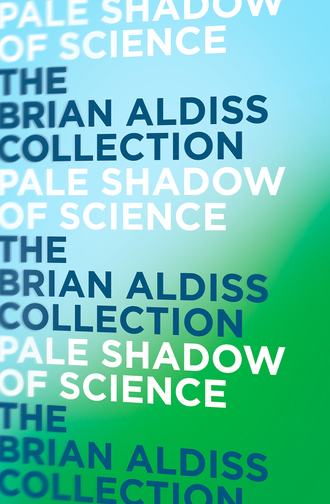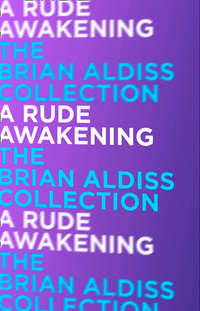
Полная версия
Pale Shadow of Science
On the way to the hotel, my wife dropped me by the council offices. The rest of the party went on their way while I went to pay the gravediggers’ fees.
Afterwards, on a whim, I walked to see the house where we had lived before we left the town in disgrace. The house stood down St Withburga Lane and was in fact called Withburga House. It faced across to the churchyard and to the church with its square tower.
There was the house still, much altered, covered with a thick stucco, and half the size I remembered it. It was now the HQ of the Brecklands District Council, or some such absurd name. The house and I confronted each other, to see how we had fared over forty years. Its fate was no worse than mine. We both survived, in our fashion.
To be truthful, I had never liked the house. I had been frightened there, at a tender age. This was where my lifelong habit of insomnia began, in the bedroom overlooking the old graves.
Our garage had been knocked down to allow for a small yard at the side. I walked round and looked over the high wooden gate into our old walled garden.
It was just as it had been, that summer we left. The terrace by the house, the old wash-room, converted into a summerhouse, the central flowerbed planted with annuals, the rustic work, the heavy laburnum at the far end, the lawn. Everything maintained.
My father made that garden. When we bought Withburga, it had been in a state of decay. Restoration had been needed inside, while the garden, a wilderness, had had to be restarted from scratch. My father had thrown himself into the work with his usual energy, digging, sowing, planting, and mixing concrete for paving and to support rustic pergolas. Staring over the gate, back into the past, I could imagine him still at work there, doing the sort of thing he liked best.
The front door of the house had been blocked off. One entered by the side, where once there had been no door. All was quiet. I wandered down a bare corridor. It was chill, unwelcoming. I saw that our old rooms had been partitioned into cubicles. Here was the kitchen, a kitchen no more. Here was our breakfast room, where the sun once filtered in on to the tablecloth, the china, the bowl of stewed apple. Here my sister’s dolls house had stood, one memorable Christmas … now there were instead three little rooms, each with a chair and a pencil on a string.
At the far end of the corridor was one of those hatches which has a button-bell outside it, against which a notice says ‘Push for Attention’; when the bell is pushed, it calls forth a girl who opens the hatch and says ‘Yes?’ With a sense of unreality, I pushed the bell. The hatch opened, and a girl said yes.
‘I used to live here,’ I said. ‘You are sitting in my dining room.’
She looked at me in some anguish. I was dressed in a black suit, with a black tie, and a black overcoat to protect me from the East wind.
‘I’ll get Mrs Skinner,’ she said.
There were three other women in our dining room, but Mrs Skinner entered from an adjoining room and bid me good-afternoon. She was a handsome woman in her mid-thirties, well-dressed with an elegant figure. She seemed to belong in that little menage no more than I did.
I told her of our family connection with the offices. She was interested. So were the other women. They stopped their work and sat with hands on laps, listening as I talked to Mrs Skinner through the hatch. Both of us craned our necks in order to see the other properly.
‘Our lounge was on the other side of the old front door,’ I said.
‘That is now my office – or part of it is,’ said the elegant Mrs Skinner, I thought with more reserve than she had shown so far.
‘Have you ever heard anything strange in there?’ I asked.
The women all looked at one another. An older woman at the back of the office, who did her hair in a bun, said, with a nervous laugh, ‘Oh, we’ve all heard strange things in this place. Some of the girls will tell you it’s haunted.’
‘It is haunted,’ said the girl at the hatch.
‘It is haunted,’ I agreed.
So I related the story of Old Bessie.
Withburga had been the home of a spinster, Bessie Someone, who had lived there in increasing decrepitude with an aged companion. My mother, given to good works, used to go to see Bessie regularly, taking her a cake, a trifle, or one of her fine steak-and-kidney puddings, wrapped in a cloth. Bessie died eventually. My father bought the house from Bessie’s executors.
Our builders moved in. They ripped out a back staircase and put in a new bathroom. They re-roofed the house. They pulled out all the rotting sashcord windows and installed metal ones in their stead. They repainted and redecorated. Then we took up residence, my parents, my sister and I. My sister would then have been four or five, and I eight or nine.
Almost at once, we started hearing the sounds. It was a winter’s evening. I sat with my parents in the living room, in the room that was to become – at least in part – the elegant Mrs Skinner’s. My sister was asleep in the bedroom above, in the room where old Bessie had died.
We heard footsteps overhead. In the centre of the living-room ceiling was a light whose china shade was supported by three chains. The footsteps were perfectly distinct. As they passed the centre of the room, the chains rattled on the lamp.
All three of us, motionless, followed the trail of the steps with our eyes, as they progressed to the bedroom window. There was a pause. Then the sound – the unmistakeable sound – of a sashcord frame being thrown up, squealing in its runners as it went.
‘There’s someone up there,’ said my father. He snatched the poker and ran upstairs. Thrilled, I snatched the fire-tongs and followed close behind.
There was no one in the bedroom, except for my sister fast asleep in her bed. The metal-frame window remained closed. My father investigated the walk-in linen cupboard – how I was to fear that cupboard later – and found nothing. Eventually, we returned downstairs.
‘It must have been old Bessie,’ said my mother.
And we laughed. We had a ghost. And it had a name. Old Bessie.
‘We never did anything but good for Old Bessie,’ said my mother. ‘So she won’t harm us.’
Well, it is true that Bessie did us no harm. But she was ever active. Most ghosts are content to live on their reputations, or reappear once a year. Not Bessie. She was always about the house. Cats would not stay with us.
The focus of the trouble was always that room with the linen cupboard, where Bessie had died, where my sister slept. I occupied the other front bedroom across the landing, while my parents slept at the rear of the house, overlooking the garden. In a very short while, my sister was bursting out on the landing in the middle of the night, screaming and crying. A lady carrying a lamp had come out of the linen cupboard, or from behind the wardrobe, to stand over her bed. So my sister always told us. A fierce lady with a lamp.
An ideal solution was discovered to this dilemma. My sister and I should change bedrooms. After all, I was by this time at boarding school, and did not sleep at home most of the year.
So I inherited the room with the linen cupboard. When you opened the linen cupboard door, drawers and lockers confronted you on two sides. On the third side was a window without a curtain, leaving the place vulnerable to the night. I always fell asleep with my gaze directed towards that ominous cupboard.
Did Bessie visit me? She did. I cannot remember whether she frightened me. I do know that I understood that here was ideal subject matter for school where, in the little dormitory, I made the nights terrible as I told them the story of Old Bessie. Boys hid their heads under the blankets in fright.
Living with Old Bessie became increasingly difficult. We told nobody in town about her. She was a disgrace, nudging us like a bad conscience.
When she started to visit us downstairs, it all got too much.
One October evening, at about four o’clock, when the dusk begins to fall with peculiar intensity in Withburga Lane, when farmers go mad from melancholy and shoot their dogs and their wives, my mother was alone in the house. My sister and I were at school. My father had not yet returned home.
Mother was in the kitchen at the rear of the house, baking one of her famous cherry cakes, when she heard someone walking about the bathroom overhead. Assuming that my father had returned early, and surprised that he had not at least called out to her, she went through to the hall.
As she removed her apron, she looked up the stairwell and spoke his name. ‘Bill?’
No response, although she still heard the footsteps. It was dark up there.
‘Bill. Is that you? Are you there?’
The footsteps came out on to the upper landing.
‘Bill? Who is it? Who’s there?’
The footsteps began to descend the stairs.
She stood petrified as they passed by her eyes. Still descending. She could not leave the stairwell. The footsteps came down to hall level. They turned and came towards her.
It was then that she found the power to scream. She dropped her apron and rushed out of the front door into the lane. There she stood, as it grew dark, and waited for half an hour before my father returned. He had to coax her into the house.
‘If Bessie’s coming downstairs, I’m leaving,’ said my mother.
We sold the house. Nobody selling property mentions the fact that it is haunted. Ghosts do not increase the saleable value. We left Withburga, and shortly after that came the family row which exiled us from Norfolk forever.
Mrs Skinner and her ladies listened to the story with intense interest, peering at me through the hatch.
Immediately I had finished, they burst into excited talk. ‘There you are, what did I tell you?’ ‘So Old Bessie’s still about then ….’
Each of them had a tale to tell. They had heard spooky noises. One of them had had to come back at night and had been too frozen with fear to go in. Another had heard footsteps which seemed to walk through the cubicles upstairs. The girl at the hatch, not to be outdone, said, ‘And when you come in of a morning, there’s always – oh, you know, a kind of sinister something … I’ve never liked working here.’
Mrs Skinner told me that she had come back one evening after the offices were closed to do some work for her boss. She had gone upstairs to his room – the very room where Bessie had died – and was working there when she heard someone downstairs. Thinking it must be her boss, she had called out. No answer. When the steps began to come up the staircase, she grew alarmed and went to see who it was. The footsteps kept coming. She saw no one. She represented herself as a lady not easily upset – and indeed I believed it – but she had been so frightened that she had run downstairs and out into the lane, where she had waited until her boss arrived.
As she finished speaking, Mrs Skinner and I both realized at the same time the congruence between her story and my mother’s. We stared at each other.
And as we stared, I saw her expression change from one of a kind of quizzical amusement to one approaching fear. Her lips parted. She could not cease staring through the hatch at me.
Perturbed myself, I said, ‘I must disappear … go and join the funeral party.’
I shut the hatch. I stood there alone. The corridor was chill and empty; its hostility closed in upon me.
As I hurried down the corridor into the open, as I left Withburga, as I moved rapidly down the lane, I knew exactly what the expresion on Mrs Skinner’s face implied. She had become, in that instant, certain that she was talking to the ghost itself.
Back at the hotel, our party was ordering its second round of gin-and-tonics.
‘Bessie’s still in residence,’ I told my sister. Even as I said it, a thought occurred to me which I will leave with you. It had been our asssumption that the haunter of Withburga was Old Bessie. But we could have been wrong. The tormented spirit which still wandered in its imprisoned limbo was possibly much older than Bessie – older and more malevolent.
Is this a true story? I don’t know. I still cannot bring myself intellectually to believe in ghosts.
This second section consists of articles on major contributors to the SF field whose work I admire greatly.
They run as follows: Mary Shelley, to whom all SF writers owe a debt, Olaf Stapledon, George Orwell, Phillip K. Dick, James Blish, and Harry Harrison.
Science Fiction’s Mother Figure
IN ANTHONY BURGESS’S NOVEL, BEARD’S ROMAN WOMEN (1977), there is a passage where Beard, the central character, meets an old girl friend in an airport bar. Both work in what it is fashionable to call ‘the media’; they discuss Byron and Shelley, and she says ‘I did an overseas radio thing on Mary Shelley. She and her mother are very popular these days. With the forces of women’s liberation, that is. It took a woman to make a Frankenstein monster. Evil, cancer, corruption, pollution, the lot. She was the only one of the lot of them who knew about life ….’
Even today, when our diet is the unlikely, Mary Shelley’s Frankenstein seems extremely far-fetched; how much more so must it have appeared on publication in 1818. Yet Beard’s girl friend puts her finger on one of the contradictions which possibly explains the continued fascination of Frankenstein, that it seems to know a lot about life, whilst being preoccupied with death.
This preoccupation was undoubtedly an important strand in the character of the author of Frankenstein. Marked by the death of her mother in childbirth, she was haunted, at the time of writing Frankenstein, by precognitive dreads concerning the future deaths of her husband and children. By embodying some of this psychic material into her complex narrative, she created what many regard as that creature with a life of its own, the first SF novel.
This perception will bear examination later. Meanwhile, it should be pointed out that Frankenstein is generically ambivalent, hovering between novel, Gothic, and science fiction, just as its science hovers between alchemy and orthodox science. To my mind, precisely similar factors obtain even today in the most celebrated SF novels. Heinlein’s Stranger in a Strange Land contains magic; Anne McCaffrey’s dragon novels hover between legend, fairy tale, and science fiction. ‘Pure’ science fiction is chimerical. Its strength lies in its appetite.
Mary Shelley’s life (1797–1851) forms an unusual pattern, with all the events crowding into the early part and, indeed, many transactions that would mould her character occurring before she was born. Both her parents played important roles in the intellectual life of the time. Her father, William Godwin, was a philosopher and political theorist, whose most important work is An Enquiry Concerning the Principles of Political Justice (1793). Godwin also wrote novels as a popular means of elucidating his thought, the most durable being Caleb Williams (1794), which can still be read with interest, even excitement, today. The influence of both these works on Godwin’s daughter’s writing is marked. Mary’s mother, Mary Wollstonecraft Godwin, was a brilliant woman who wrote the world’s first feminist tract, A Vindication of the Rights of Woman (1792). Mary Wollstonecraft came to the marriage with Godwin bringing with her a small daughter, Fanny, the fruit of her affair with a charming but elusive American, Gilbert Imlay, who deserted his pregnant mistress in the Paris of the Terror.
A portrait of Mary Wollstonecraft by Sir John Opie shows a moody and passionate woman. Distracted by the failure of her love for Imlay, she tried to commit suicide by jumping into the Thames off Putney Bridge. She survived to marry Godwin and bear him a daughter, Mary. After the birth, puerperal fever set in, and she died ten days later.
Godwin remarried. His second wife was a Mrs. Mary Jane Clairmont, and she brought with her two children by her previous marriage, Charles, and Jane, who later preferred to be known as Claire and bore Byron an illegitimate child, Allegra. Fanny and Mary, then four years old, were further upset by the arrival of this new step-mother into their household, and the alienation was no doubt increased when Godwin’s new wife bore him a son in 1803. The five children crowded into one house increased Mary’s feeling of inner isolation, the refrain of which sounds throughout her novels and short stories. Another constant refrain, that of complex familial relationships, is seen embodied in the five children, no two of whom could muster two parents in common, Charles and Jane excepted.
Mary grew to be an attractive woman.[1] Her reserved manner hid deep feelings baffled by her mother’s death and her father’s distance – two kinds of coldness, one might say, both of which are embodied in her monster’s being in a sense dead and also unloved. When Shelley arrived, he received all her love, and Mary remained faithful to him long after his death, despite his callow unfaithfulness to her. She was also a blue stocking, the product of two intellectuals, and through many years maintained an energetic reading programme, teaching herself several foreign languages. Moreover, she had the good fortune to know in childhood many of the celebrated intellectuals and men of letters of the time, Samuel Taylor Coleridge among them. Trelawny said of Mary that ‘her head might be put upon the shoulders of a Philosopher.’
Enter Percy Bysshe Shelley, poet, son of a baronet. An emotional and narcissistic youth, full of admiration for Godwin’s revolutionary but now somewhat faded political theories. When nineteen, he had married Harriet Westerbrook. He soon fell in love with Mary, and she with him. Before his twenty-second birthday, the pair had eloped to France, taking Jane with them.
Europe! What freedom it must have represented to Mary, after her sixteen circumscribed years, and what close companionship Shelley, handsome and intellectual, must have offered. But these youthful travellers were among the first to enter France after the Napoleonic Wars, and a desolate place they found it, the fields uncultivated, the villages and buildings destroyed. On the way to Switzerland, Shelley wrote to invite Harriet, now pregnant with Shelley’s second child, to join the party. Before they reached Lake Lucerne, Mary knew that she also was pregnant.
Catastrophe followed the harum-scarum young lovers. Mary’s child, a daughter, was born after they returned to London and their debts; it was premature and died. A second child, William, scarcely fared better. In the summer of 1816, Shelley and Mary went to Switzerland again, taking along William and, inevitably, Claire, as Jane now called herself. On the shores of Lake Geneva, they found accommodation at the Maison Chapuis, next to the Villa Diodati, where the poet Lord Byron was staying. Although Claire threw herself at Byron’s head, and managed to encompass the rest of him too, it was a happily creative time for them, with philosophy and learning pursued as well as the more touted facets of the good life. Here, Mary began to write Frankenstein. Summer had too short a stay, and the party returned to England to face more trouble.
Mary’s self-effacing half-sister, Fanny, committed suicide with an overdose of laudanum at the age of twenty-two, by which time the Shelley menage had moved to the West Country; Claire still followed them, as the monster followed Frankenstein, and was now also pregnant. Then news reached them that Shelley’s wife Harriet had drowned herself, not in the Thames, but in the Serpentine. She had been far advanced in pregnancy. Shelley and Mary were married almost immediately.
The date of the marriage was 29 December 1816. Six and a half years later, in July 1822, Shelley was drowned whilst sailing on the Ligurian Sea. By that time, the little boy, William, was dead, as was another child, Clara; Mary had also had a miscarriage, but a further son, Percy Florence, was born. He alone of Mary’s progeny survived to manhood. Even Claire’s daughter by Byron, the little Allegra, had died.
The rest of Mary’s life is curiously empty, lived in the shadow of her first twenty-five years. After Byron died in Greece in 1824, both the great poets were gone – a loss to English letters. Mary remained ever faithful to the memory of her husband. She edited his poems and papers, and earned a living by her pen. She wrote historical novels, such as Perkin Warbeck (1830), Lodore (1835), which enjoyed some success, short stories, and one novel, The Last Man (1826) which, by its powerfully oppressive theme of world catastrophe, is classifiable as science fiction. Percy married. Her cold father, Godwin, died; Shelley’s difficult father died. Finally, in 1851, the year of the Great Exhibition, Mary herself died, aged fifty-three.
This painful biography, as confused as any modern one, is worth retelling, for it helps to explain not only why Mary’s temperament was not a sanguine one, but where much derives from what we read in her two science fiction novels, Frankenstein and The Last Man. Both owe a great deal to the literature that preceded them; more is owed to experience. Critics are liable comfortably to ignore the latter to concentrate on the former.
The essence of the story of Frankenstein is familiar, if in distorted form, from many film, stage and TV versions, in which Victor Frankenstein compiles a creature from corpses and then endows it with life, after which it runs amok. The novel is long, and more complex than this synopsis suggests. It is a flawed masterpiece of growing reputation, and an increasing body of criticism attests to the attraction of both its excellences and its flaws.
Frankenstein or, The Modern Prometheus begins with letters from Captain Walton to his sister. Walton is sailing in Arctic waters when he sees on the ice floes a sledge being driven by an enormous figure. The next day, the crew rescue a man from a similar sledge. It is Victor Frankenstein of Geneva; when he recovers, he tells his tale to Walton, which account makes up the bulk of the book, to be rounded off by Walton again, and to include six chapters which are the creature’s own account of its life, especially of its education. If the style of the novel is discursive, Mary Shelley was following methods familiar to readers of Richardson and Sterne; the method became unfashionable but, to readers of eccentric modern novels, may now be increasingly sympathetic and help to account in part for the new-found popularity of the novel.
One of the enduring attractions of the book is that Mary sets most of the drama, not in the seamy London she knew from childhood, but amid spectacular alpine scenery, such as she had visited with Shelley. The monster’s puissance gains greatly by this association with the elements, storm, cold, snow, desolation.
Interest has always centred on the monster and its creation (it has no name in the novel, merely being referred to as ‘creature,’ ‘daemon,’ or ‘monster,’ which accounts for the popular misusage by which the name Frankenstein has come to be transferred from the creator to the created – a mistake which occurred first in Mary’s lifetime. This is the essential SF core of the narrative: a fascinating experiment that goes wrong: a prescription to be repeated later, many times, in Amazing Stories and elsewhere. Frankenstein’s is a Faustian dream of unlimited power, but this Faust makes no supernatural pacts; he succeeds only when he throws away the fusty old reference books, outdated by the new science, and gets to work on research in laboratories.








